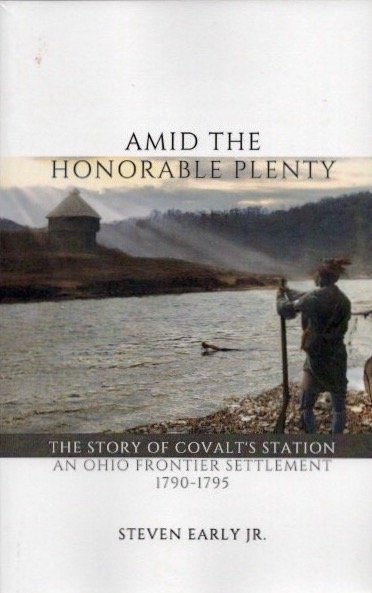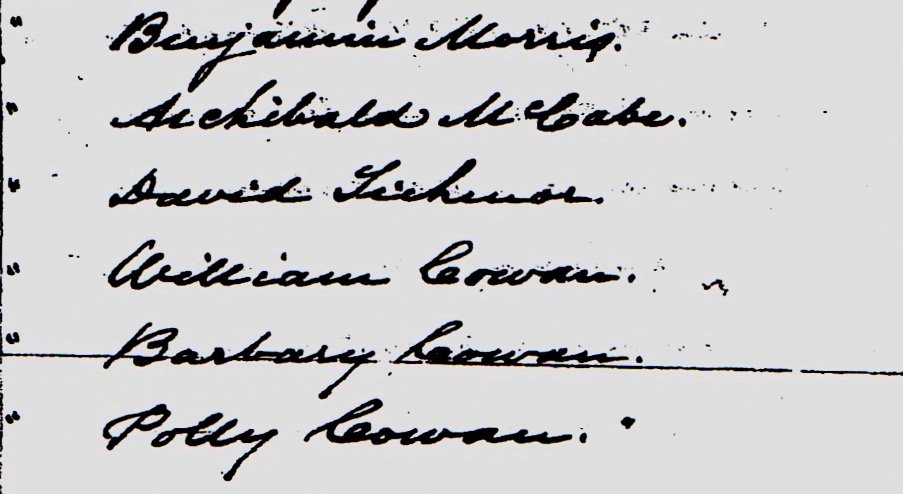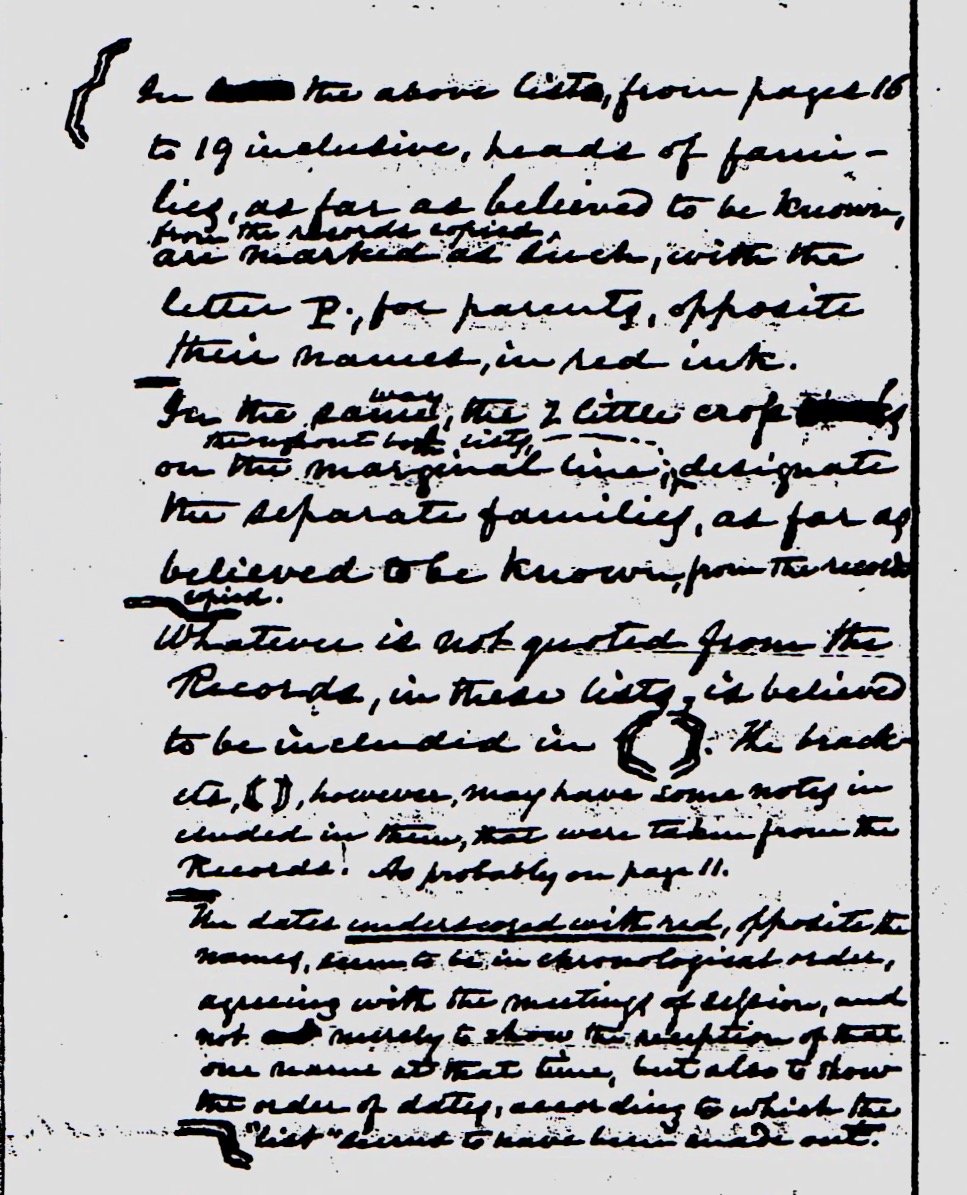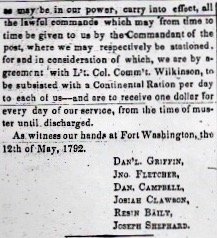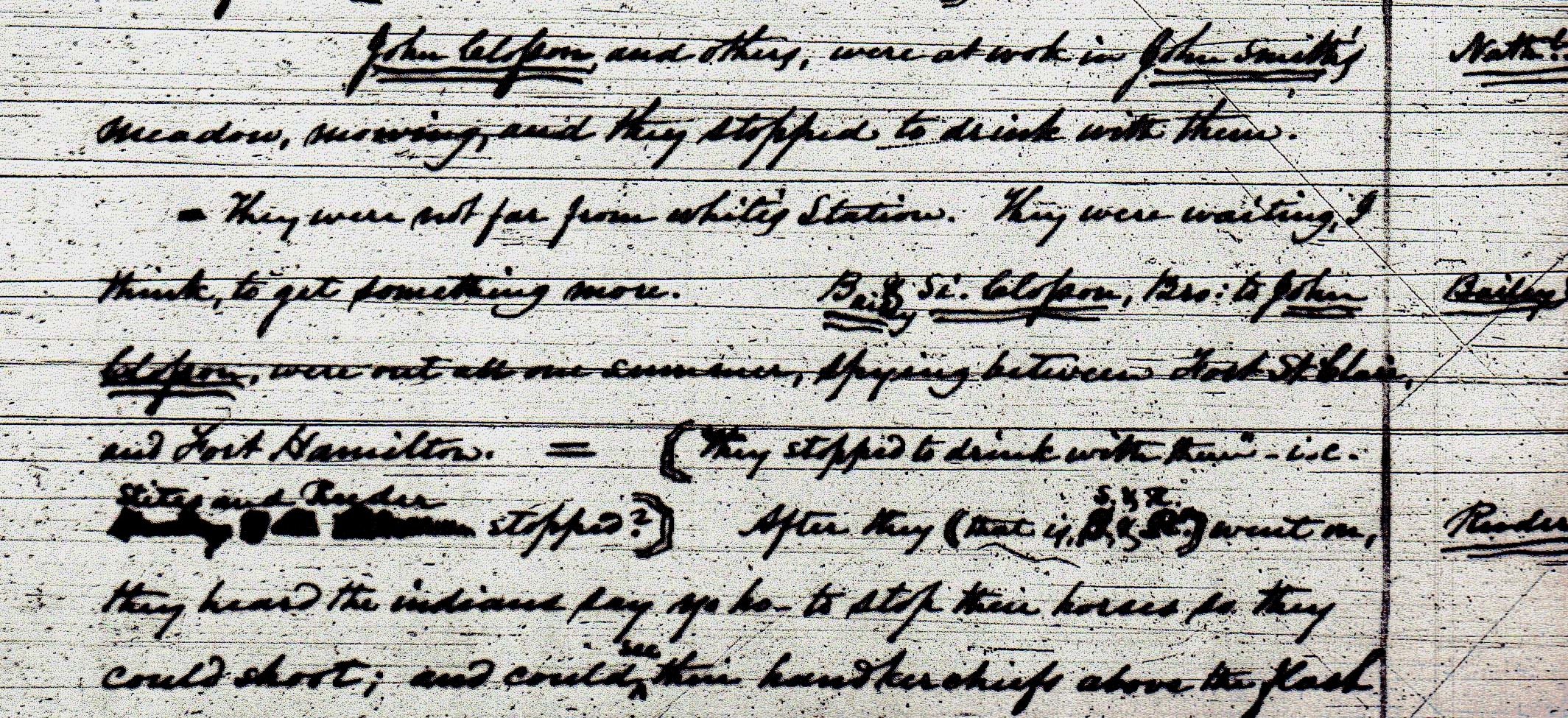
Covalt Station - Frontier Southwest Ohio 1790-1795 - References to The Clawson Family
In the late 1780’s, southwest Ohio “opened up for settlement”. Kentucky had long since had white settlers, but north of the Ohio River was off limits and was inhabited by indigenous peoples. When the Northwest Territory was created in 1787, which included modern day Ohio, Fort Washington was established - and the area around it eventually was named Cincinnati. The Columbia settlement just to the east was made at the mouth of the LIttle Miami River. John Cleves Symmes was granted land to sell by Congress in southwest Ohio - known as the Symmes Purchase - and he settled at North Bend, to the west of Fort Washington down the Ohio River.
The next three additional settlements were “forts” - or “stations” - out from Cincinnati and Fort Washington - Dunlap’s, Ludlow’s, and Covalt. One of the outermost - Covalt Station (and also known as Covalt’s Station) - was settled by Abraham Covalt, a Revolutionary War veteran, roughly eleven miles up the Little Miami River from Columbia - an area now within the modern city of Terrace Park - in the first months of 1790. The fort was one hundred feet by four hundred feet, and allowed individual “cabins” for entire families to live within its walls.
As white settlers increasingly settled on lands that where Native Americans traditionally lived, the hostilities increased with the surrounding indigenous peoples. In the first years Captain Covalt was killed outside the fort, as well were his son Abraham Jr. and other individual Covalt Station residents. Soldiers were sent out from Fort Washington to protect the settlers. One was Captain Cornelius Sedam, whose rendering of the station was included in the Draper Paper histories and is at the head of this page.
The death of Captain Covalt was referred to in many different historical accounts of these early years, and took on a status as a story that represented the conflict of the times. As a result, it was repeated regularly by people who did not have first hand experience of that event.
A photo of a prototype of Covalt Station - which matches the rough layout of the Sedam sketch - appears in the 1990 C. Richard Covault family history book, “Covalt-Covault-Cavolt”. It is unclear what this is from or how it was put together:
My fourth great-grandmother Mary Clawson, a widow from southwest Pennsylvania, came down the Ohio River with her children and their families - likely also in early 1790 - and were among the families that settled at Covalt Station. There is a question about whether the family lived at Columbia for a time before moving out to Covalt Station, but records indicate they were there for much of the time it was a fort.
I had started my own history of Covalt Station (which I would share with anyone interested). However, Steven Early Jr. has since written and published a comprehensive history - “Amid the Honorable Plenty” - which tells the story of Covalt Station in well-documented and contextual detail. My Clawson family shows up in this history, but I have more records of their time there that include them than are shown in this work.
So this web page guides the researcher to Steve Early’s work, as well as four other books that give good history to this time and place - and then presents the records that document the Clawsons presence at Covalt Station and the region during this period. I believe I have all the Clawson references from 1790-1795 included, but it is always possible I missed something and welcome any additions or corrections.
The Clawsons before Covalt Station . . .
My first suspected Clawson ancestors appeared in southwest Pennsylvania ca 1775. A Garret Clawson appeared in a Pennsylvania local militia unit in 1775, and for decades many believes that was a Garret Sr., whose widow Mary showed up in Washington County tax records in 1781. Many researchers now believe that this first record may be Mary’s son Garret. Mary’s youngest children were born in the 1775-1777 period, indicated that the father was still alive then. But it is unclear who he was. A companion web page on this website contains the records of the Clawsons in southwest Pennsylvania.
It is believed Mary’s husband - whoever he was - was of Dutch ancestry, and was more immediately from New Jersey before bringing his family to the southwest Pennsylvania frontier. He appeared to be married to Mary Clawson, who appeared alone in Washington County tax records in 1781 - apparently a widow by then. She was believed to have had seven children - Peter, Garrett, John, Mary, Thomas, Josiah, and Hannah. Frank Crosswhite’s research, also contained on another page under the Clawson tab on this site, explores the Dutch ancestry question.
Four of her children were in local records before the family left Pennsylvania. Sons Peter and John appeared in local military units. Sons Thomas and Garrett bought land. All four of them were in local tax records - as was Mary - before they disappeared from records in southwest Pennsylvania not long before the 1790 federal census. They were shown in Greene Township, which in 1796 after they left, separated from Washington County and became Greene County.
Mary and her late husband, who died sometime after his militia service and before the tax record of 1781 (researchers disagree on who he was - some believe he was Garrett Clawson, others believe he was named John Clawson). Of their children, Garrett Jr. remained in Pennsylvania and the rest came to frontier Ohio with their mother. My third great grandfather Josiah Clawson was but fifteen when they came. By the time of the move to Ohio, Peter, John, and daughter Mary were likely already married and had children.
The best background sources on Covalt Station . . .
A Border Life - Experience and Memory in the Revolutionary Ohio Valley, by Elizabeth Perkins, published by the University of North Carolina Press in 1998. This book relies in chief on the interviews of historian John Dabney Shane, later acquired by Wisconsin historian Lyman Draper and included in the Draper Papers. It is a work on what life was like in the settlements in the Ohio Valley in both Kentucky and Ohio. It is a good overall work on life in this area at this time. This book is still available from the University of North Carolina press as well as online book services.
Frontier Memories, As taken from the Shane Interviews Rev. John Dabney Shane of the Draper Manuscripts, compiled by Dale Payne, published by the author in 2002. The Border Life book above describes life in the early settlements of the Ohio Valley. The book relies on interviews conducted by the Rev. John Dabney Shane and incorporated into the Draper Papers. Frontier Memories is the verbatim transcript of many of these interviews - where the reader can see the direct words that were written down by Shane. It is valuable for any researcher. [NOTE: There are later editions, Frontier Memories II and Frontier Memories III, but the original, with the cover below, seems to include all the relevant interviews with regard to Covalt Station. Those interviews seem to be included in Frontier Memories III. At this writing, those volumes are available from various booksellers online.
The Early Settlement of the Miami Country by Ezra Ferris, which has appeared in a number of different forms. Ferris was six years old when his family settled in Columbia in 1789. Therefore, he had vivid personal memories of the frontier period in southwest Ohio. He wrote a series of letters detailing his recollection of that time - which were originally published in the Lawrenceburg (Indiana) Independent Press from 1850 to 1852. Then the Indiana Historical Society published the letters in 1897 (which is how I first came upon them). Then in 2018 these were re-published in book form by Forgotten Books. A copy of the book can be ordered through a number of services, including from the Forgotten Books website.
Stockades in the Wilderness, published in 1986 by he Commonwealth Book Company and authored by Richard Scamyhorn and John Steinle - focuses on thirty-six different forts or “stations” in southwest Ohio at the time of the original white settlement. The focus of this book is to compile information on each of the stations from many different original sources, in addition to a chronology and map. Covalt Station warrants ten pages. This is a definitive work of these forts in this period. It is out of print and only available from online book services. I got my own copy through the American Book Exchange (ABE).
Amid the Honorable Plenty: The Story of Covalt’s Station An Ohio Frontier Settlement 1790-1795, by Steven Early Jr., published in 2022 and sold through Barnes and Noble. This is a definitive work on the History of Covalt Station. Original sources such as the interviews by John Dabney Shane, the history by Ezra Ferris, and many more, are woven into a story of the station and the events surrounding it. There could not be a better history on this subject. I am proud to be referred to in it.
My Clawson Ancestors at Covalt Station . . .
The Clawsons arrived in frontier Ohio sometime in the first half of 1790, as they are not present in the 1790 Pennsylvania census by the time it was taken in the late summer of that year. Decades later Abraham Covalt’s daughter Mary Covalt Jones left a narrative on the trip to Ohio and the time at Covalt Station, which is printed in its entirely in Steve Early’s book. The Clawsons do not appear in that original trip, which left Pennsylvania about January 1, 1790. Abraham Covalt and three Clawsons - Thomas, Peter, and John - appeared nearby each other in the Pennsylvania 1789 tax records. But by the time of the first federal census, taken in August 1790, none were still in Pennsylvania. The Clawsons must have come down the Ohio River between January and August, 1790. Over the next five years, they appeared in various records in frontier Ohio.
One of the best sources of information in this period were the interviews that John Daney Shane did of survivors of the southwest Ohio frontier which were incorporated into the Draper Papers. There were many references to Covalt Station and the people who lived there as part of frontier live. There were Clawson references in these interviews, but it was not always easy to determine when in the 1790-1795 period some of these events happened. These interviews were central to both the Perkins and Early books. Gary Purviance, another Clawson descendant, actually transcribed many of these interviews. To the extent they are used below, I hope to have the original and the transcription for clarity.
Timeline of the Earliest Events that Happened in the Cincinnati Area. A book published in the 1800’s, Cincinnati Miscellany, and referred to also below in a listing for Josiah Clawson as a frontier “spy”, lists a time line of some of the early activities in the area about Cincinnati in the early 1790’s. It helps with some other records - such as those documented in the interviews of John Dabney Shane - to place them in time. that timeline is posted just below.
Make it stand out
Whatever it is, the way you tell your story online can make all the difference.
Make it stand out
Whatever it is, the way you tell your story online can make all the difference.
Make it stand out
Whatever it is, the way you tell your story online can make all the difference.
1794 Map. A Bulletin of the Cincinnati Historical and Philosophical Bulletin in 1952, posted below, contains a hand-written map of the area and forts in this period. It should be noted that the first three forts outside of the Ohio River settlements ca 1790 were Covalt, Dunlap, and Ludlow - shown here. Since by 1794, there were other settlements, this map makes the region look more developed. This map does not note Round Bottom, a settlement not far from Covalt Station. But initially, as some of the historical recollections below will point out, the travel via trail between Columbia and Covalt’s Station was very dangerous in this period and people died making that trip.
Columbia Baptist Church. This was the first church in the Ohio Territory, started in March 1790. John Dabney Shane copied records of the church, and in the frontier period, both Mary Clawson and Thomas Clawson were in one reference as members. The Clawson daughter Mary was already married to Joseph Shanks at this time, and Thomas married Sophia Covalt in 1794 and she was not in this listing - so it is likely that this listing is in the 1790-1794 period. It is possible that the Clawsons, while living initially in Columbia, were members at that time.
But it is more likely that, as the only church at that time, they traveled from Covalt Station to attend - when it was safe and they could. I have posted the heading, the list of members (Mary is listed as #33 and Thomas as #34), and an explanation written by Shane with the record. He referred to the original records in that explanation, but some of these things are not clear from his transcription. He does have lines that list Thomas and Mary as a family group.
[NOTE: In the Marjorie Byrnside Burriss book of early Hamilton County records, there is a listing of members admitted to the Columbia Baptist Church through 1820 - and the Clawsons are not among them. The Clawsons begin to be shown in the Sugar Creek Baptist Church records not long after 1800. That church was located near where they resided at the time - in Washington Township in what became Montgomery County in 1803.]
Fort Hamilton Militia, January 1792. As the “hostilities” raged on in this period, a Hamilton County militia unit was called into service out of Fort Hamilton. Thomas, Peter, and Josiah Clawson were members, under the leadership of Captain Brice Virgin. The original roster is posted below. There are many familiar names on the list besides the Clawsons.
A note from my John Clawson research references the above list and a second list of Captain Flinn: The Quarterly Publication of the Historical and Philosophical Society of Ohio - Page 98 – in the volume that appears to be 1920, shows a complete listing of Capt. Brice Virgin’s militia, as reported at Fort Hamilton on January 27, 1792. Among those privates on the list were Thomas, Peter, and Josiah Clawson. Jas. Newell appeared on the list right before Josiah. Cheniah Cavolt appeared immediately following Peter Clawson with Isaac Gerard preceding him. John Jerrard followed Thomas Clawson on the list. There was a column in the listing for “Publick” and “horses” and the Clawsons had a mark for each next to them.
There was a muster roll for Capt James Flinn for the same days with the location of N. W. Territory of the Ohio River given, and John Clawson was shown with “horses” checked. Luke Foster was listed just one line below him. It is possibly significant that the Clawsons were listed in two different units. John may have lived separately from Thomas, Peter, and Josiah in this early period.
Josiah Clawson - first reference as “spy”. In a book of the 1800’s on Cincinnati Miscellany, referenced above with the timeline of various activities in this region in the early 1790’s, there is a letter acknowledging six men as “spies”. [There is a second reference to Josiah as a spy, shown below, in General Wayne’s 1794 campaign.]
The article, titled “The Early Scouts of Cincinnati”, begins: “We, the subscribers, having engaged as Spies, Scouts, and Messengers, in the service of the United States, to be stationed at Forts Hamilton, St. Clair, and Jefferson, do ?? bind, and oblige ourselves, to receive obey, and ?? . . . [picks up on the printed page below]
Make it stand out
Whatever it is, the way you tell your story online can make all the difference.
Of the names above, a Fletcher was in the memoirs of Abraham Covalt’s daughter Mary Jones on the first days of Columbia, and John Fletcher is shown above in the militia unit. And Reason (Rezin) Bailey was in the February 1792 petition of residents at Covalt Station. A similar reference to this one above appeared in an early Butler County, Ohio history as well.
Benjamin Stites Interview (First Reference). Benjamin Stites was one of the earliest settlers in Southwest Ohio, and was interviewed by John Dabney Shane. In the first of two references from Benjamin Stites, he recounts the death of Abraham Covalt Jr., and refers to Harmar’s defeat, which happened in the fall of 1790. There is a reference to John and Thomas Clawson killing an Indian, which is included in the Steven Early book, but about which I am embarrassed. Posted first is the original from the notes of John Dabney Shane, and second, the transcript by Clawson descendant Gary Purviance.
Benjamin Stites Interview (Second Reference). One interview describes an incident at John Smith’s house. John Smith was a significant figure in early Ohio. He was an early minister who actually married Thomas Clawson and Sophia Covalt in 1794, and was later a U. S. Senator from Ohio. An excerpt from a John Dabney Shane interview with him follows. First, the entire page. Second the closeup of the Clawson reference. Third, the transcription by Gary Purviance. [Gary is a Clawson descendant who I have shared research with for many years. He did a comprehensive index of Clawson deeds in Fountain County. He was so enthused about the references in the Draper Papers that he did a set of transcriptions of many of the interview. I haven’t been in touch for five or six years - I emailed him about this page and the email bounced back.]
The incident mentioned is undated, but it mentions Fort St. Clair, which was established near modern day Eaton, Ohio in 1792. Since it mentions the summer, it is likely a reference to 1792 or 1793. It also mentions Si (Josiah) Clawson, brother to John, which is significant because some researchers did not think John Clawson was in Ohio at this time.
Ezra Ferris - The Settlement of the Miami Valley, 1897. Another great source for this period is the Ezra Ferris history of the Miami Valley Settlement - which is referenced above in the four background sources for the period and Covalt Station. Letters Ezra Ferris wrote were published in the local Lawrenceburg Indiana press in the early 1850’s. Then the letters were published as a series of letters by the Indiana Historical Society in 1897 (where I got the copies of his work) - it has recently been republished in book form. In general, it is an excellent background on the early times in southwest Ohio, but there are some mentions of the Clawsons.
Two of the letters are posted below. The first letter is from 1851 is posted in its entirety just below. It mentions the Clawsons as one of the families in Columbia, and then tells the story of a couple of incidents that are mentioned above in the Draper Papers. Interestingly, Eza Ferris, who had an ancestor in the early Miami Valley Settlement, lived in Lawrenceburgh, Indiana, where my Laird ancestors settled about 1815. It is quite likely they knew each other. A second letter, which mentions John Clawson, is posted below the first letter, is dated December 29 - likely 1851.
The second letter with the reference to John Clawson, is posted just below.
Make it stand out
Whatever it is, the way you tell your story online can make all the difference.
Make it stand out
Whatever it is, the way you tell your story online can make all the difference.
Make it stand out
Whatever it is, the way you tell your story online can make all the difference.
Make it stand out
Whatever it is, the way you tell your story online can make all the difference.





